Wild Blackberries: How to Find & Pick This Tasty Fruit
Author: Jen Worst | Editor: Omar Alonso
Review & Research: Jen Worst & Chris Miller

Come summer, one of Mother Nature’s most delicious bounties populate the wild in abundance— wild blackberries!
These berries, along with raspberries, are the easiest to identify, growing in tiny clusters that are a signature of the fruits. And the best part? They’re absolutely free for the picking.
If you’re planning to make your summer fruitful (pun totally intended) and go picking wild blackberries, this article will take you from the ‘A’ to the ‘Z’ of blackberry picking, so you can enjoy these delicious, easily pickable gifts of nature.
Wild Blackberry Varieties
Though we're concerned with the wild variety, it's amazing that blackberry cultivation began as far back as 1850-1860, though we've picked the wild blackberry as far back as human memory goes.
Of the millions of edible berries that grow in the wild, blackberries (Rubus allegheniensis), as well as raspberries, are super easy to identify and pick of the edible berry bushes. More importantly, they’re unmistakable, without any doppelgangers, so you’re not at risk of accidentally possibly poisoning yourself with these fruits.
Types of Wild Blackberries
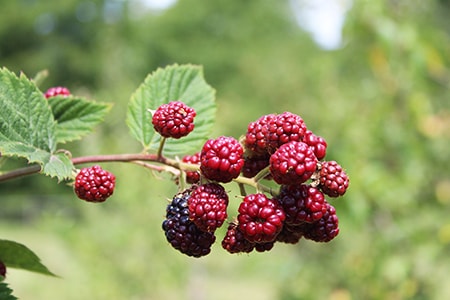
Though many different species of blackberries (also commonly called 'brambles') grow everywhere and are important sources of food for many animals and birds, only four are found commonly in the United States:
- Cutleaf blackberry
- Himalayan blackberry
- Western thimbleberry
- Pacific blackberry.
The Himalayan blackberry is extremely common in California, desert regions excepted, while the cutleaf blackberry is common in areas with an elevation up to 6,200 feet.
The Western thimbleberry is common in areas with streams and ditches, while the Pacific blackberry is highly common in California.
Despite their great taste, these four types are also considered weeds, with the Himalayan blackberry being the most abhorred.
All blackberries are edible, at their blackest when fully ripe. Since most types of raspberries can turn either red or black when ripe (depending on the type), it’s easy to confuse the two.
What Do Wild Blackberries Look Like?
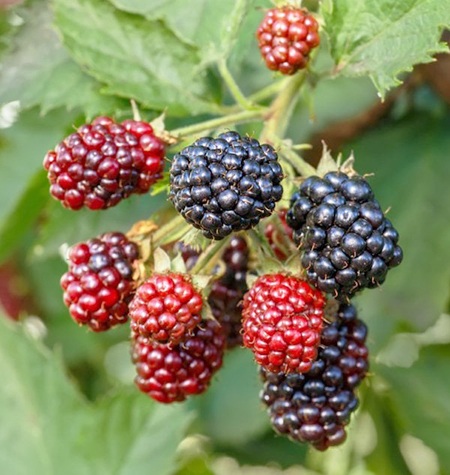
Blackberries begin as pollinated flowers, but as the berries ripen on the inside they turn from green balls to pinkish and green clusters of balls. As they continue to age they'll turn red and ultimately black and larger in size.
While raspberries are cup shaped and hollow, whereas blackberries are solid, right up to the stem. Give yourself a little time and practice and telling the two apart will get easier.
When you pull the blackberry cluster away from the plant it will leave a flat hollow on both the berry cluster and the plant, as opposed to a cone-shaped nodule on the raspberry plant.
What Do Blackberry Bushes Look Like?
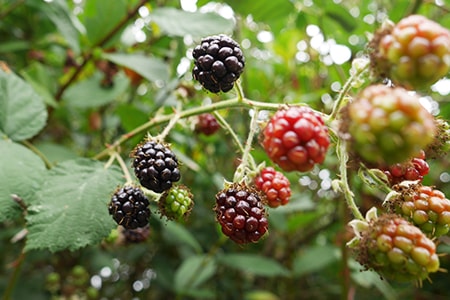
Wild blackberry plants feature oval-shaped compound leaves (generally three) with teeth along the edges and grow in thorny brambles (though thornless varieties can be and are cultivated).
The leaves have pinnate venation with serrated margins. The underside of the leaves are lighter on the bottom and can be told apart from black raspberry leaves because those are far lighter on the bottom.
They grow canes that develop roots after they grow long enough that their weight flops them over and causes them to touch the ground. These canes (also called stems) feature thorns. The stems will feature ridges vertically, and are not smooth or round but angled.
The blackberry bushes feature thorns on the stems and branches that are very stiff and unforgiving if you scrape yourself against them. The thorns are of similar color to the stems.
When Do Wild Blackberries Ripen?
Generally, all wild blackberry vines flower and produce fruit from May to September, depending on the variety. If the climate is cooler, the wild berries ripen in July, whereas in warmer climes, the berries ripen as early as May, letting you enjoy several weeks of berry picking!
How to Pick Wild Blackberries
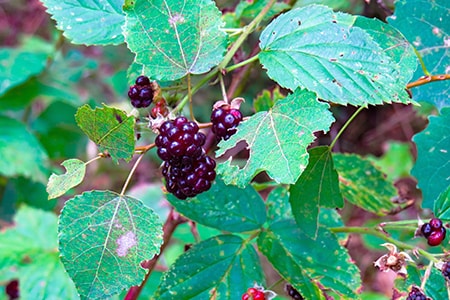
The following tips will help you pick out wild blackberries easily.
Locating Berries: To say that blackberries are commonly found in the summer is an understatement. From living fences to overgrown meadows to sunny roadways, you can spot wild berries anywhere. They’re especially common at the edges of wooded areas, as well the edges of farmlands, pastures, and country highways.
Gear Up: As mentioned, wild blackberries are thorny, growing in the wild with friends like poison ivy, mosquitoes, wasps, snakes, and ticks. Therefore, closed shoes, long sleeves, and full pants will help protect you from bites, scratches, and stings. If necessary, gloves will also help, but may snag on the thorns.
Be Noisy: Make a lot of noise! As mentioned, blackberries are the main course of the feast for many other beings, from snakes and bears to tiny critters. Making noise will alert these of your presence, ensuring both your safety and theirs, likely causing them to run off.
Pick Ripe Berries: The best part about wild blackberries is that once they’re picked, they don’t ripen, so ensure that you’re picking ripe berries. You can identify these by their large, plump bodies, deep coloring and the fact that they slip easily off the stem. Tugging means that the berry isn’t ready to be picked yet.
Take a Container Along: This one’s a little obvious, but carry a container that’s spacious enough to accommodate your berries. A shallow basket or any types of buckets, lightweight colanders, and plastic bowls are all great; you can fill up the container, but want to ensure that the berries don’t press down.
After Picking the Wild Blackberries
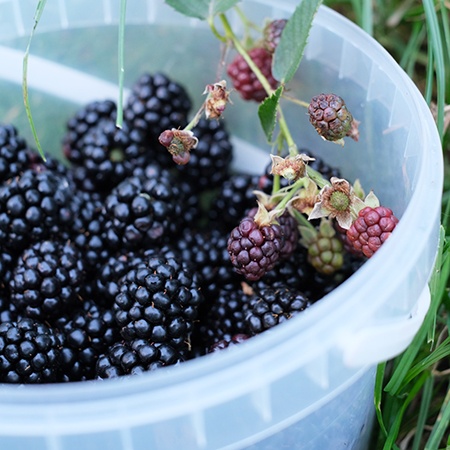
Once you’ve picked your berries, you want to enjoy them for the longest possible period, so here are a few tips to help you with the same:
Storing Berries: Keep berries in an area with plenty of shade and once you get home, put them in the cooler or fridge at the earliest. This way, you’re squeezing out a few more days, even a week, longer than normal. Wash them only before using them—a simple rinse in cool water is sufficient.
Bathe Your Berries: Many folks like to soak their wild blackberries in a saltwater bath for an hour to two (1:1 ratio of cup:gallon, respectively) so that any critters and worms hiding inside can be dislodged.
Eating Your Berries: If any berries make it home after the picking, you can enjoy them in a range of recipes. Sprinkle them fresh over salads and cereals, make pies and cobblers, make blackberry types of jam or freeze your berries to use in smoothies and healthy treats (blackberries are ridiculously rich in antioxidants and vitamins).
After all that effort, you don’t just want your blackberries to go to waste, so ensure that you’re treating them gently while storing them.
Avoid crushing your berries and if you’re washing them right after picking them, freeze them immediately. Not doing so will result in fuzzy mildew growth all over the berries.
Additionally, store the berries in shallow, airtight containers so that the berries aren’t crushed under their own weight.
Wild Blackberry Things to Keep in Mind
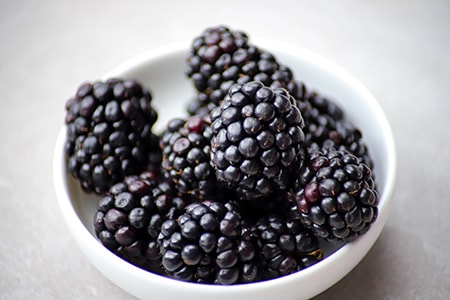
Remember, while looking for wild blackberries, don’t give up on spots that seem to be populated only by red berries; the really good ones are generally hiding behind these and are only visible when you get closer.
Look on the ground, lower branches, and under the brambles and you may just hit the jackpot!
Also, it helps to pick blackberries early in the morning, before temperatures rise, so that the fruit is still firm and not given to crushing.
It bears repeating—protect yourself on your berry-picking trip. Long hair is better fastened (you don’t want to spend your trip detangling the brambles from your hair, instead) and if necessary, wear a hat.
This, along with plenty of water (very important since berry weather is hot weather), will keep heat exhaustion at bay. Wearing light-colored clothing will also help protect against the heat.
Additionally, stay away from the perfume, florals especially, as these can end up attracting insects, especially the kind that stings.
Some people also use insect repellents, though these could end up contaminating your berries. Instead, stick to thick, heavy pants and tuck your pant legs into the socks so that no ticks end up exploring your legs.
Heavy rubber boots that extend above the ankles are great as protection against snakebites, as well as for stomping down any big brambles or clear a path to get to the fruit.
If you’re hard strapped for containers, anything works, even a thoroughly-washed milk jug, provided the top is big enough for you to put your berries through. Coffee cans also work great.
You may also realize that blackberries look extremely similar to dewberries, though the former ripen faster and the latter is juicier and larger. Dewberries also grow along the ground and are not as abundant as blackberries, growing one to a stem instead of in clusters.
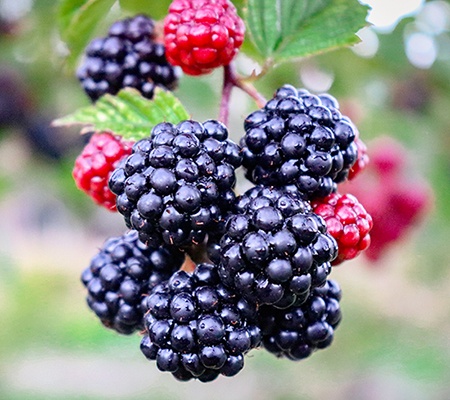
Dewberries are a sign that the blackberries are coming, coming in a week or two before the blackberries hit.
Blackberries can be harvested multiple times, as they ripen in waves. You can also throw in half-ripe wild blackberries when picking ripe ones, as these have more pectin and are great for setting jelly.
Ensure you’re keeping a lookout for any fungus or bugs, sticking to berries that are clean, healthy and ripe.
It may also help to pull the berries to the side instead of straight, to get them to come off easier. And if you’re unsure of whether the berries you’re picking are any good, you can taste a few berries to ensure that you are picking out the sweetest, ripest ones—win-win!
That's How to Find Wild Blackberries!
Wild blackberries are not only delicious but generally free for the taking! They are truly nature’s bounty, making summers super delicious.
Additionally, they’re easy to cook and incorporate in any recipe—you don’t even have to feel guilty, thanks to how healthy these fruits are.
In fact, many folks love blackberries so much that they cultivate their own—however, though this is doable, it isn’t recommended, as the plants are at high risk of insect infestations and diseases, making them super hard to grow.
If you’re picking fruit in the wild, ensure that it is, indeed, the wild and not someone’s private property. In case it is, always ask permission before doing so.
Remember, over protection and finding the right spots and berries, patience is the key to fruitful berry picking. The best berries are often hidden in the plant’s middle, so searching out the ripest berries may take some time.
However, no pain, no gain, so keep at it and don’t get discouraged; the fruits of labor are always sweeter, indeed. Enjoy your wild blackberries!



